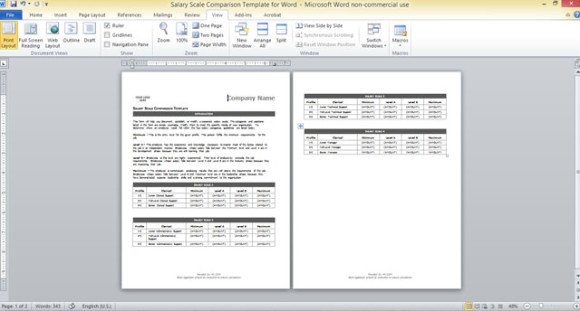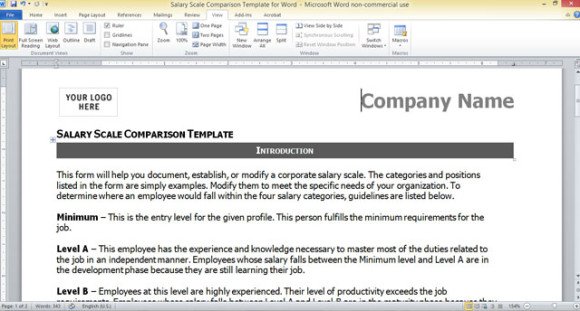Salary Scale Comparison Template for Word
A pay scale or a salary scale is a system that every company should have for its employees. A salary scale determines how much an employee should earn depending on a variety of factors. These factors would include the employee’s rank or status within your company’s organization, the length of time that the employee has been working for your company, and the difficulty of the task or job description. The free Salary Scale template for Word makes it easy for business owners or human resource personnel to keep an effective salary scale system.

The Salary Scale Comparison Template is a free template that helps you record, establish, modify and keep track of your corporate salary scale. The Salary Scale Comparison Template for Word comes with a pre-made set of categories and positions that you can modify or fill in to suit your organization. You can set a salary scale for your employees and list them all in the Word template so you can compare the items with each other. It can also be used as part of a salary survey management tool or wage analysis.

There are also guidelines that come with the Salary Scale Template for Word. These guidelines will show you which category a specific employee falls. The Salary Scale Comparison Template has four pre-made salary categories that you can modify.

As mentioned earlier, the free Salary Scale template for Microsoft Word makes it easy for business owners to keep an effective salary scale system. There are plenty of tools available for determining a salary scale, but using a compensation tool that delivers market-based and survey-based insights enables businesses to make data-driven decisions that can help them retain successful employees and attract new talent.
The Salary Scale Comparison Template features four categories:
- Minimum – The entry level for a given profile. These employees fulfill the minimum requirements of the job.
- Level A – These employees have the experience and knowledge necessary to master most of the duties related to the job in an independent manner. The employees falling within the minimum and Level A categories are in the development phase because they are still learning about the job.
- Level B – Employees under this level are highly-experienced. Their productivity exceeds the job requirements. Employees between Level A and Level B can be considered to be in the maturity phase mastering the job.
- Maximum – These employees are continuously producing results that are well above the requirements for the job. Employees falling between Level B and Maximum categories are in the leadership phase because they have demonstrated superior leadership skills and a strong commitment to the organization.
Go to Download the Salary Scale Comparison Template for Word
